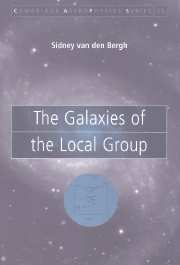Book contents
- Frontmatter
- Contents
- Preface
- 1 Introduction
- 2 Local Group membership
- 3 The Andromeda galaxy (M31)
- 4 The Milky Way system
- 5 The Triangulum galaxy (M33)
- 6 The Large Magellanic Cloud
- 7 The Small Magellanic Cloud
- 8 The elliptical galaxy M32 (= NGC 221)
- 9 The irregular dwarf galaxy NGC 6822
- 10 The starburst galaxy IC 10
- 11 Faint dwarf irregular galaxies
- 12 Spheroidal galaxies
- 13 The most luminous dwarf spheroidal galaxies
- 14 Dwarf spheroidals in the Andromeda subgroup
- 15 Faint dwarf spheroidals
- 16 The outer fringes of the Local Group
- 17 Intergalactic matter in the Local Group
- 18 Dynamical and physical evolution
- 19 Properties of the Local Group
- 20 Conclusions
- Glossary
- Bibliography
- Object Index
7 - The Small Magellanic Cloud
Published online by Cambridge University Press: 22 August 2009
- Frontmatter
- Contents
- Preface
- 1 Introduction
- 2 Local Group membership
- 3 The Andromeda galaxy (M31)
- 4 The Milky Way system
- 5 The Triangulum galaxy (M33)
- 6 The Large Magellanic Cloud
- 7 The Small Magellanic Cloud
- 8 The elliptical galaxy M32 (= NGC 221)
- 9 The irregular dwarf galaxy NGC 6822
- 10 The starburst galaxy IC 10
- 11 Faint dwarf irregular galaxies
- 12 Spheroidal galaxies
- 13 The most luminous dwarf spheroidal galaxies
- 14 Dwarf spheroidals in the Andromeda subgroup
- 15 Faint dwarf spheroidals
- 16 The outer fringes of the Local Group
- 17 Intergalactic matter in the Local Group
- 18 Dynamical and physical evolution
- 19 Properties of the Local Group
- 20 Conclusions
- Glossary
- Bibliography
- Object Index
Summary
Introduction
The Small Cloud is an irregular dwarf of DDO type Ir IV–V that has a low mean metallicity and a high mass fraction remaining in gaseous form. These characteristics suggest that the SMC is, from an evolutionary point of view, a more primitive and less evolved galaxy than the Large Cloud. The metallicity difference between the Galaxy and the LMC was discovered by Arp (1962), who wrote: “Taken together with the marked differences in the evolved giant branches and [C]epheid gaps in the SMC and [G]alactic clusters, there exists the inescapable implication that the chemical composition of the SMC stars is different from the chemical composition of the solar neighborhood.”
The fact that the SMC contains only a single true globular cluster may indicate that star formation started off later, or more gradually, than it did in the Large Cloud.
At the present time the SMC is forming stars less actively than is the LMC. Prima facie evidence for this is that the Small Cloud contains much smaller, and less spectacular, H II regions than does the Large Cloud. Furthermore, the LMC presently contains 110 massive Wolf–Rayet stars, whereas there are only 9 WR stars in the Small Cloud. Finally, CCD observations by Bothun & Thompson (1988) show that the SMC is redder than the LMC. They find B – V = 0.52±0.03 for the Large Cloud, versus B – V =0.61±0.03 for the integrated color of the Small Cloud.
- Type
- Chapter
- Information
- The Galaxies of the Local Group , pp. 142 - 162Publisher: Cambridge University PressPrint publication year: 2000

